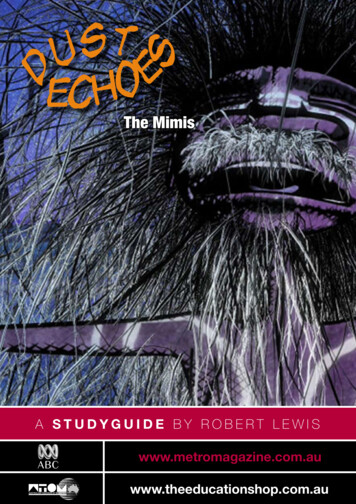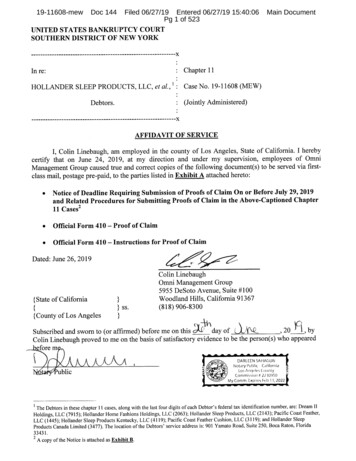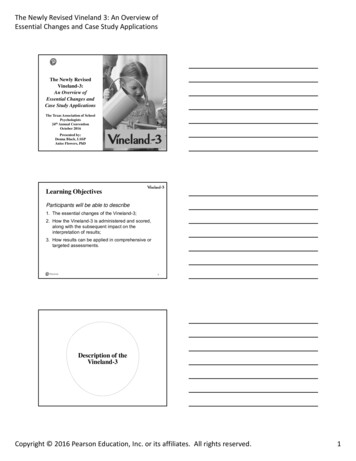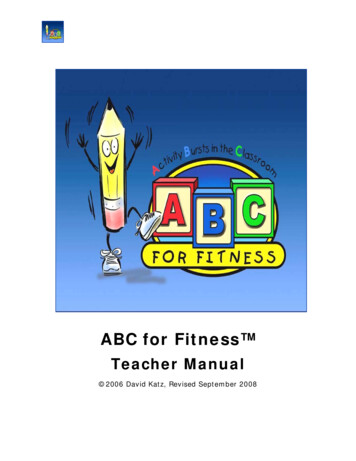
Transcription
The MimisA STUDYGUIDE by Robert com.au
TEACHER’SGUIDEBrief summaryA young man believes he isa disappointment to hisfather. He is taken by thefriendly creatures, the mimis,who teach him to be happyand joyful. His father findshim, and there is a joyfulrealization that his fatherloves him.The main theme of the story isabout relationships and identity.The original storyThere is a boy sitting at thecamp while everybody else goeshunting. He is sitting and thinking,‘I’ve gotta get out and do somehunting! I’ve gotta try it!’. But thenhe remembers the fact that he isa bad hunter – hopeless – he justdoesn’t possess the skills or talentfor hunting. He can hardly throw aspear and he definitely can’t trackan animal, even if his life countedon it!In the late afternoon, the cool-time,everyone comes back with heapsof fish and kangaroo, and the boylooks at them and feels shamed andembarrassed because he doesn’thave the same hunting abilities.So, inspired, the boy gets up andleaves the camp to go hunting. Hetakes with him a sharpened stickbecause he wants to catch anechidna.He walks and walks and looks andsearches all the way up to the hills,but can’t find a single echidna!But as the sun sets, a magical thinghappens. The hills begin to moveand change shape. All aroundhim the hills begin to part as theshadows stretch and slide.This is the time of day when themimis come out of the underworld,from out of the earth and hills toprepare the land for the next day.They are the ones who keep thecountry tidy. They groom thebushes, feed the fish and fix brokenbranches. They look after the land!The mimis are very tall and thin.They are human-like stick people.The mimis are spirit creatures, wholeave no tracks! They are also fun,playful, and magical.The boy looks on in amazement asSCREEN EDUCATION 2
the small group of mimis tend tothe land.At first the boy is scared of themimi spirits. The mimis entice andenchant him with their magic andcarry him into their home in thehill. Then the hills close over andreturn to their original position andshape.The mimis take the boy into theirunderworld, where there is dancing,eating, fun and frivolity. They playand tease. They are good spirits,happy spirits!The boy forgets about his world.The mimis give him wives and makehim part of their family! They keephim in their underworld and thememory of his own family and hisown camp fades.In the meantime, his father iswaiting all night.‘Where is my son?’ he thinks. ‘I’vebeen waiting all night. Where couldhe be?’So the boy’s father walks out ofthe camp at the crack of dawnand follows his sons tracks. He isskilled at the art of tracking. Evenif someone jumped on a rock, hecould tell because of the marks leftunder the stone!The old man follows his son’sfootsteps until, for some magicalreason, there are no more tracks!If some wild animal ate him therewould at least be some sign of astruggle. But there is nothing – nota trace!The boy’s father is confusedand perplexed by the suddendisappearance of his son. So hesits on the ground, and begins tochant, and eventually goes into atrance. With his magic he can hearthe mimis dancing and singing andmaking merry. So, he continues tosing and chant. He wants to reachthis underworld.The old man’s hair grows andgrows. It seeps into the groundand creeps deep into the earthin search of his son. His chantingfollows his hair and the son beginsto hear the chanting of his father ashis hair grows closer and closer!‘What’s that sound?’ he thinks. ‘DoI know that sound?’The old man’s hair grows until itcoils itself right around the boy, andthe father pulls up his son out ofthe earth, as if he had just caught alarge fish out of the river!The boy snaps back into reality,and his father takes him back tothe camp. The boy then realizesthat the camp needs all kinds ofpeople with all kinds of skill and heis no longer envious of his fellowhunters.loses some of its much neededdiversity.Where this story comesfromThe story is owned by the Dhuwamoiety at Wugularr (Beswick)Community. This is an old storyfrom Tom’s uncle George Weisen,brother of old Jimmie Weisen. Itwas told when they used to gohunting in the spring country atlunchtime, making teas and cookingtheir catch for the morning. OldGeorge used to tell this storyaround the campfire.What this story meansIn Bongalin Bongalin there is asong and dance for the mimispirits. In this story it takesthe old man’s songs to bringhis son back from the mimi’sunderworld.The message of this story isthat acceptance shouldn’t beexperienced by trying to besomething or someone wearen’t. Accepting our weaknessesmay help us discover our strengths,but pursuing our weaker skills maylead to being lost forever.In this story the father loves hisson regardless of his weaknesses.When the boy leaves, the campSCREEN EDUCATION 3
SuggestedclassroomactivitiesIntroducing the storyUnderstanding the story1 Tell the students the originalstory. Ask them to create a roughstoryboard setting out how theywould tell the story themselves.Students then watch the film.2 Now have students answer thecomprehension questions on theStudent Worksheet (Questions1-3), or from the online quiz.ORHave the students reorganizethe summary sentences on theStudent Worksheet to tell acoherent story. Students thenwatch the film.Finding meanings, reflectionand analysis3 Students can now discuss thethemes and issues set out inquestions 4-9, including theiranalysis of how the filmmakersuse the medium to tell the story.Follow-up activities4 Teachers can select from theactivities list in the What is ‘Dust Echoes’ study guide tosuggest appropriate follow-upactivities for this story.The main theme of the story isabout relationships and identity.SCREEN EDUCATION 4
STUDENT WORKSHEETTitle: The MimisSorting out the story1 Here is a summary of the story. But it is mixed up. Rearrange the sentencesand number them 1-5 so that they tell the story in the correct sequence or order.Order No.SummaryHe is angry and disappointed by this, and runs away.His father misses him and searches for him.A young man tries to be a great hunter like his father, but he fails.The boy and his father finally find each other.He is taken by the mimi spirits, who teach him to dance and be happy.Understanding what this story is about2 Here are some more questions about the story. To answer these, you will sometimes need to look carefully at howthe animators have depicted the scene. Why does the boy want to be a great hunter?Why is each person important for the group?What type of creatures are the mimis?What do the mimis teach him?Why is he able to be so happy with them?When his father finds him, what does the boy realize?Why is this important to him?Is the boy different as a result of his experience?Understanding what this story means3 Aboriginal stories may exist to: teach young people about natural eventswarn them about dangersexplain relationships and identityteach them about the law and right behaviourWhich of these is The Mimis trying to achieve? Give reasons to support your answer.4 The stories are also about ideas. Write one sentence to explain what this story tells us about each of these: LoveBelongingThe strength of family and countryDuties and responsibilitiesJourneysIdentitySCREEN EDUCATION 5
STUDENT WORKSHEET CONTINUED5 The Mimis is about joy. Describe a moment when youfelt joy. Find some music to back that story – such asis done with the joyful music in The Mimis.You mightlisten to a hymn like Ode To Joy as a starting point. The film’s graphic style – What do the people looklike? What does the background look like? Whatcolours are used?What does the story help us understandabout Aboriginal people’s lives? The film’s use of music – Is it traditional Aboriginalmusic or modern music? How does the musicinfluence your reactions? Is it effective?6 What does the film help us understand about any ofthese topics or aspects of traditional Aboriginal life andsociety? What other sounds are in the film – Are naturalsounds used? Is there any other sound, such aspeople’s voices? FoodWorkFamilySocietyLaw and rulesDutiesSpiritual/religious beliefsEducationTechnology (tools and weapons)Relationships with othersRolesEmotions.Write one sentence for any of these that you think istouched on in the story.Understanding how the story hasbeen told7 What were your reactions or feelings during the story?8 You had these reactions and feelings not only becauseof the story itself, but also the way the story was toldand shown to you.Here are some of the elements or parts of a film thatcan influence you. Divide them among your group, andhave group members report back on them. The use of viewpoint – There is no camera filmingthe action in each story, but you can see the artistspresenting the images as if there is. What are the‘camera’ angles that are used? Does the ‘camera’remain at ground level, or does it change angles?Does it move? What is the effect or impact ofchanging our viewpoint as we watch the film? Narration – Some of the stories have a narrator.What sort of voice is it? How does the narrator tellthe story? Does he just speak, or are there otherelements that he includes? Is it effective?Applying the story to your life9 Dust Echoes is one way that we are bringing everyoneback to the same campfire – black and white.We are tellingour stories to you in a way you can understand, to helpyou see, hear and know. And we are telling these stories toourselves, so that we will always remember, with pride, whowe are.– Tom E. Lewis, Djilpin Arts Aboriginal Corporation.The makers of the story want it to be a part of yourlife. Do you think the story has any relevance to yourlife today? Explain your ideas.SCREEN EDUCATION 6
This study guide was produced by ATOMeditor@atom.org.au ATOM 2007For more information on Screen Education magazine, or to download other free study guides,visit www.metromagazine.com.auFor hundreds of articles on Film as Text, Screen Literacy, Multiliteracy and Media Studies,visit www.theeducationshop.com.auNotice: An educational institution may make copies of all or part of this study guide, provided that it only makes and uses copies as reasonablyrequired for its own educational, non-commercial, classroom purposes and does not sell or lend such copies.SCREEN EDUCATION 7
takes with him a sharpened stick because he wants to catch an echidna. He walks and walks and looks and searches all the way up to the hills, but can’t find a single echidna! But as the sun sets, a magical thing happens. The hills begin to move and change shape. All around him










